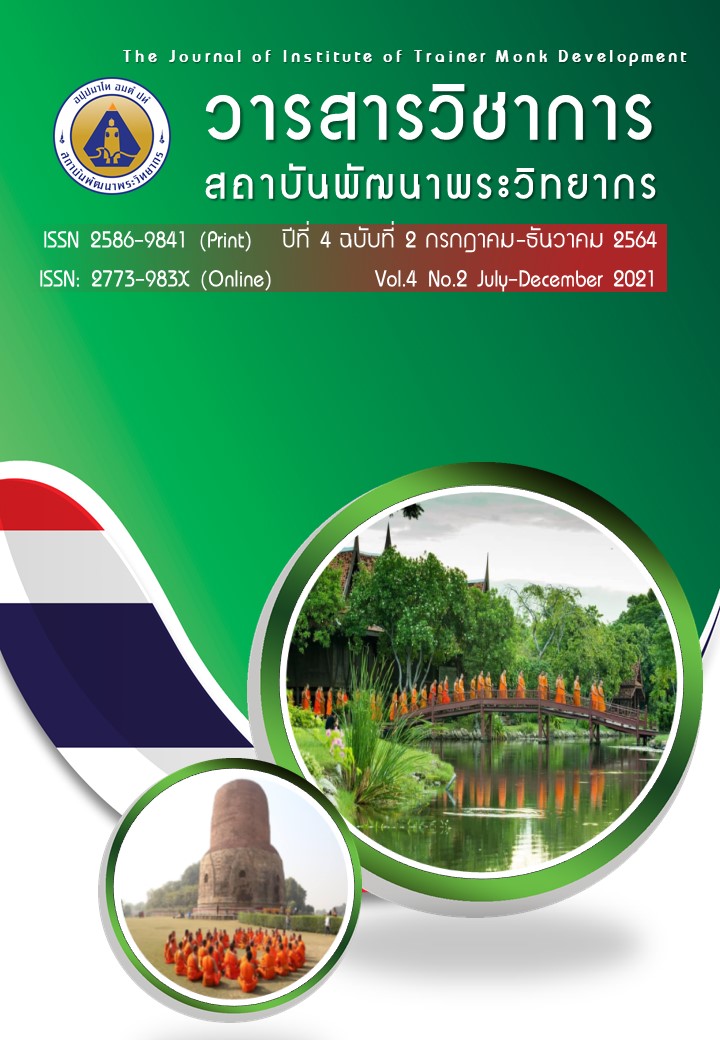Haupleung: Value and Significance in Way of Life of the Surin Khmerian Buddhists
Main Article Content
Abstract
This article aims to study Haupleung tradition in the Khmer Community of Surin, explore the Surin Khmerian Buddhists' lifestyle, and analyze the value and importance of Haupleung tradition in the Surin Khmerian Buddhists way of life. The documentaries studies and In-depth interviews were used. The presentation used descriptive-analytical methods. The results had found that 1) Haupleung tradition of the Surin Khmerian Buddhists, the word ‘Plueng’ is the Khmer language which means Kwan or sprit. Kwan lives with people’s minds. According to Khmerian and Kuy, there are nine-teen kwans in one human mind which help the mind in common. But if there’s an incident that scares the person, it’s going to scare known as “La Lue Plueng” (spirit is missing a number.) or “Pat Plueng” (Frightened or unable to live with the flesh). It is necessary to perform the “Huapleung ritual” of “Huapleng” (the spirit’s invitation ritual). There are two kinds of this ritual. 2) According to the way of life of the Surin Khmerian Buddhists, there are traditions similar to Khmer people in Cambodia. The colloquialism used is Khmer, Kuy, and Lao. They believed in Buddhism but still believed in the enchantment and the black magic in older generations. 3) Analyzing the value and importance of Haupleung tradition in the Surin Khmerian Buddhist way of life, there are three aspects, namely: 1) mental aspect: to restore the mental state to normal, morale, energetic, buzzing and stable-minded. 2) Belief’s aspect: there is a belief that a person must have a Pleung with morale, to have a spirit from birth to death. When the Kwan (spirit) has not existed in the body, there is called to the body, with sacrifices containing incense and fragrant flowers believed to attract the invisible to forgiveness. Finally, in harmony, the consensus of relatives to call the sick in the family must be loved, enlisted, cooperated. That's family harmony.
Article Details
บทความที่ได้รับการตีพิมพ์เป็นลิขสิทธิ์ของวารสารวิชาการสถาบันพัฒนาพระวิทยากร
ข้อความที่ปรากฎอยู่ในบทความที่ได้รับการตีพิมพ์ในวารสาร ถือเป็นความรับผิดชอบของผู้เขียนบทความ และข้อคิดเห็นนั้นไม่ถือว่าเป็นทัศนะและความรับผิดชอบของกองบรรณาธิการวารสารวิชาการสถาบันพัฒนาพระวิทยากร
References
ธวัช ปุณโณทก. (2546). ความเชื่อพื้นบ้านสัมพันธ์กับวิถีชีวิตในสังคมอีสานในวัฒนธรรมพื้นบ้าน : คติความเชื่อ. กรุงเทพฯ : โครงการไทยศึกษา จุฬาลงกรณ์มหาวิทยาลัย.
บุญเกิด พิมพ์วรเมธากุล. (2544). ประเพณีอีสานและเกร็ดโบราณคดีไทอีสาน. ขอนแก่น : โรงพิมพ์คลังนานาวิทยา.
ปราวิณีย์ ไชนามนต์. (2564). เอกลักษณ์ทางวัฒนธรรม. สืบค้นเมื่อวันที่ 28 สิงหาคม 2564, จาก https:// sites.google.com/site/52010814054inetg1/ngan-sng-xacary/naeana-canghwad-surinthr/phathnakar-thang-pra-wati-s/xeklaksn-thang-wathn-th.
พระพรหมคุณาภรณ์ (ป.อ.ปยุตฺโต). (2558). พจนานุกรมพุทธศาสตร์ฉบับประมวลธรรม. พิมพ์ครั้งที่ 31. กรุงเทพมหานคร : บริษัท เอส.อาร์ พริ้นติ้ง แมส โปรดักส์ จำกัด.
พระบุญช่วย โชติวํโส (อุ้ยวงค์). (2553). ศึกษาหลักธรรมทางพระพุทธศาสนาในความเชื่อและพิธีกรรมการบายศรีสู่ขวัญของชาววานรนิวาส จังหวัดสกลนคร. (วิทยานิพนธ์พุทธศาสตรมหาบัณฑิต สาขาวิชาพระพุทธศาสนา). บัณฑิตศึกษา: มหาวิทยาลัยมหาจุฬาลงกรณราชวิทยาลัย.
พระยาอนุมานราชธน (เสฐียรโกเศศ). (2506). ขวัญและประเพณีการทำขวัญ. กรุงเทพมหานคร : สำนักพิมพ์ก้าวหน้า.
พระครูโกวิทสุตาภรณ์. (2563). บุญข้าวสาก: มิติความเชื่อและพิธีกรรมทางศาสนากับคุณค่าเชิงจริยะในสังคมไทย. วารสาร มจร ปรัชญาปริทรรศน์ 3(2): 42-54.
ไพฑูรย์ มีกุศล. (2547). ไทยกวย : ชนพื้นเมืองดั้งเดิม. อาศรมวัฒนธรรม. ม.ป.ท. : ม.ป.พ.
มนัส สุขสาย. (ม.ป.ป.). การบายศรีสู่ขวัญ. อุบลราชธานี : ศูนย์การศึกษานอกโรงเรียนภาคตะวันออกเฉียงเหนือ.
มหาจุฬาลงกรณราชวิทยาลัย. (2539). พระไตรปิฎกฉบับภาษาไทย ฉบับมหาจุฬาลงกรณราชวิทยาลัย. กรุงเทพฯ: โรงพิมพ์มหาจุฬาลงกรณราชวิทยาลัย.
มูลนิธิสารานุกรมวัฒนธรรมไทย ธนาคารไทยพาณิชย์. (2542). สารานุกรมวัฒนธรรมไทยภาคอีสาน : เล่ม 8และ เล่ม 15. กรุงเทพฯ : มูลนิธิสารานุกรมวัฒนธรรมไทย ธนาคารไทยพาณิชย์.
ยโสธารา ศิริภาประภากร. (2559). วิเคราะห์คำสอนจากพิธีกรรมเข้าทรงมะม๊วตที่สัมพันธ์กับหลักธรรมในพระพุทธศาสนาของกลุ่มชาติพันธุ์ไทยเขมรในเขตจังหวัดสุรินทร์และจังหวัดบุรีรัมย์. (ดุษฎีนิพนธ์พุทธศาสตรดุษฎีบัณฑิต สาขาวิชาพระพุทธศาสนา). บัณฑิตวิทยาลัย : มหาวิทยาลัยมหาจุฬาลงกรณราชวิทยาลัย.
ราชบัณฑิตยสถาน. (2556). พจนานุกรมฉบับราชบัณฑิตยสถาน พ.ศ. 2554. กรุงเทพฯ : นานมีบุ๊คส์พับลิเคชั่นส์.
รุจินาถ อรรถสิษฐ และคณะ. (2548). ขวัญ : ขวัญชีวิตของคนไทย. พิมพ์ครั้งที่ 1. นนทบุรี : กรมพัฒนาการแพทย์แผนไทยและการแพทย์ทางเลือก กระทรวงสาธารณสุข.
ศูนย์มานุษยวิทยาสิรินธร (องค์การมหาชน). (2564). ฐานข้อมูลกลุ่มชาติพันธุ์ในประเทศไทย. กลุ่มชาติพันธุ์ : ขแมร์ลือ. สืบค้นเมื่อวันที่ 28 สิงหาคม 2564, จาก https://www.sac.or.th/databases/ethnic-groups/ethnicGroups/160
สาร สาระทัศนานันท์. (2540). พิธีสู่ขวัญและคำขวัญโบราณอีสานฉบับสมบูรณ์. กรุงเทพมหานคร : โรงพิมพ์กรมการศาสนา.
สัมภาษณ์ นายเสรี อุปถัมภ์. (2564). ปราชญ์ชาวบ้าน. ตำบลลำดวน อำเภอลำดวน จังหวัดสุรินทร์. สัมภาษณ์, 28 สิงหาคม.
สัมภาษณ์ นางสำรวม ดีสม. (2564). หมอทำขวัญ. ศิลปินมรดกอีสาน. ตำบลคอโค อำเภอเมือง จังหวัดสุรินทร์. สัมภาษณ์, 28 สิงหาคม.
อรรถกถาสิริชาดก. (2564). ว่าด้วยโภคะเกิดแก่ผู้มีบุญ. สืบค้นเมื่อวันที่ 4 พฤศจิกายน 2564, จาก https://84000.org/tipitaka/attha/jataka.php?i=27045
อาหมัดอัลซารีย์ มูเก็ม. (2559). ประเพณี พิธีกรรม ความเชื่อ ที่มีความสัมพันธ์ต่อวิถีชีวิตของชนกลุ่มชาติพันธ์เขมรบน พื้นที่บ้านจารย์ อําเภอสังขะ จังหวัดสุรินทร์. (หลักสูตรประกาศนียบัตร (บัณฑิตอาสาสมัคร). วิทยาลัยพัฒนศาสตร์ ป๋วย อึ้งภากรณ์ : มหาวิทยาลัยธรรมศาสตร์.
อุบล สวัสดิ์ผล และคณะ. (2561). โครงการฮาวปลึงจองไดกับการรื้อฟื้นความสัมพันธ์ข้ามแดนชุมชนท้องถิ่นไทย-กัมพูชากรณีศึกษา: บ้านไพรพัฒนา ตำบลไพรพัฒนา อำเภอภูสิงห์ จังหวัดศรีสะเกษ ประเทศไทยกับภูมิเจิงพนม คุ้มตะเปียงไปร เชราะอัลลองเวง เขตอุดรมีชัยราชอาณาจักรกัมพูชา. (รายงานวิจัย). สำนักงานกองทุนสนับสนุนการวิจัย (สกว.) ฝ่ายวิจัยเพื่อท้องถิ่น.


